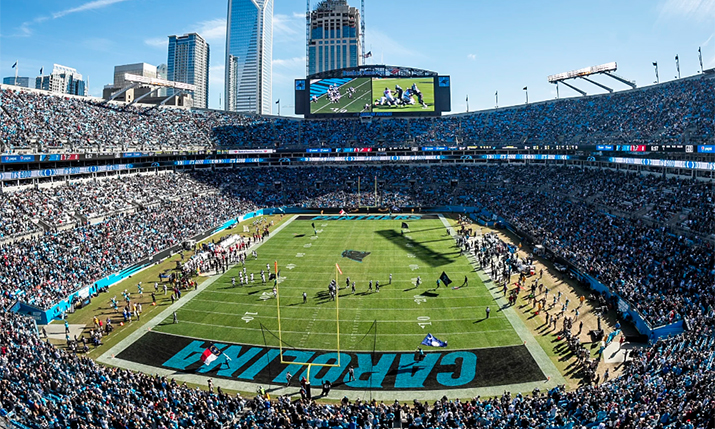Upgrading video production: Grass Valley on IP and HDR workflows in venues

By Peter Abecassis, Grass Valley senior product marketing manager.
In-venue entertainment must compete with the at-home experience, and the video that plays at sporting events is a huge part of what makes a trip to the stadium unforgettable.
As such, 2022 has seen an increasing number of stadiums upgrading their video production systems to bring HDR video to their in-venue fans. For HDR to truly create an impact, it needs to happen throughout the production chain: from cameras and conversion, all the way to switching and monitoring, and increasing the resolution to 1080p or UHD also has a huge impact.
In fact, most venues have different types of screens, therefore must support both 1080p and UHD signals at the same time. Workflows need to support running top-quality HDR video in UHD, with other destinations needing 1080p. Not all sources will support HDR, so having the ability to down-map to SDR is also necessary.
Adding to all this, to capture the detail and emotion of premier sporting events, today’s venues want to be able to have as many camera angles as possible. The larger the venue, the more cameras, feeds, and outputs you’re likely to have.
Upgrade to SMPTE 2110
With so many video formats flying around, it’s critical that venues have an infrastructure that is flexible enough to give everyone the signal they need in the correct format. Between UHD and HD, HDR and SDR, or IP and SDI, the number of signals and formats keeps multiplying. Venue infrastructure requires a platform that can bridge SDI technology and IP SMPTE ST 2110 connectivity. Because these signals use varying amounts of bandwidth, the orchestration system needs to manage all the various signals in both the baseband and IP domains.
As venues seek to improve their video quality, they’re finding that a larger upgrade to SMPTE 2110 is both necessary and desirable.
Making the whole facility 2110 increases flexibility and scalability. The ability to add in additional capacity for a new gateway or more channels is greatly simplified. You throw down a device, whether it’s an up, down, cross, or some sort of processor, and it’s just a part of the network and you can utilise it wherever it is.
All the infrastructure is simplified. You no longer need DA’s and all these other extra components for distribution. This means that you start saving money and seeing the ability to do things more efficiently. It’s huge savings in terms of space, in terms of power, and in terms of heat.
Given all the benefits, 2023 will see more and more venues making the move to full 1080p HDR workflows over IP and looking for equipment that can handle all the necessary formats over 2110 natively.
Ensuring the system runs natively in SMPTE 2110 and supports HDR all the way through is key to success, as it simplifies the integration and allows the venue to benefit from the advantages of IP. Having a single, consolidated, overarching configuration, control, and monitoring package gives venues the complete capability of combining UHD HDR production with the flexibility of an IP system.
Plug and play
Having a camera that plugs directly into the IP network without the need for a cradle simplifies the entire IP installation and increases the number of potential camera locations. Specific camera locations can be easily modified for every type of event. Being able to easily license any camera with options such as UHD HDR at three-times high speed means that the venue can easily be reconfigured for any event without a huge upfront investment. The ability to simultaneously output UHD HDR and 1080p HDR allows the camera to support workflows where both signal types are required.
A sports venue switcher needs more than just all-IP with a ton of inputs, outputs, and ME’s in full-raster UHD. It also needs to be integrated with the graphics systems, the effects systems, and the scoreboard controller and have macros and e-mems that can make multiple changes with the click of a button.
With the flexibility of IP systems, the demands on the rest of the processing infrastructure can change as well. For this reason, it’s best to use flexible processing platforms that can be software updated for different applications. This way, as requirements change, the processing gear can change too. Functions such as up/down/frame sync-gearbox processing allow venues and stadiums to make the most of UHD and HDR formats while still providing a down-converted version for HD SDR outputs. Packing lots of audio and video processing power in a small form factor results in savings in terms of space and power.
From producing large game-day productions to corporate events and high school graduations, being able to quickly reconfigure your facility saves time and allows for greater creativity when planning each production. An orchestration system needs to be able to quickly reconfigure hundreds of processing cards at the click of a button.
The only way to keep all these signals straight is with an orchestration system that was built from the ground up to deal with IP networks and baseband routing and processing. Systems designed for the dynamic orchestration of media networks, whether they’re SDI, IP, or a mixture of the two give the ability to build, configure and change systems on-the-fly, whether it’s adding and removing devices, or simply changing a name. Make sure the orchestration system is designed with open standards, so integration with third-party devices is simple, providing flexibility and choice.
Creating an optimal fan experience at a venue or stadium is more than just maximising the number of pixels. Making sure the whole workflow takes advantage of HDR makes every pixel count. Using IP technology simplifies the implementation of HDR and UHD and it means that the production setup can be configured and reconfigured more easily, creating the ideal set up for every production.
